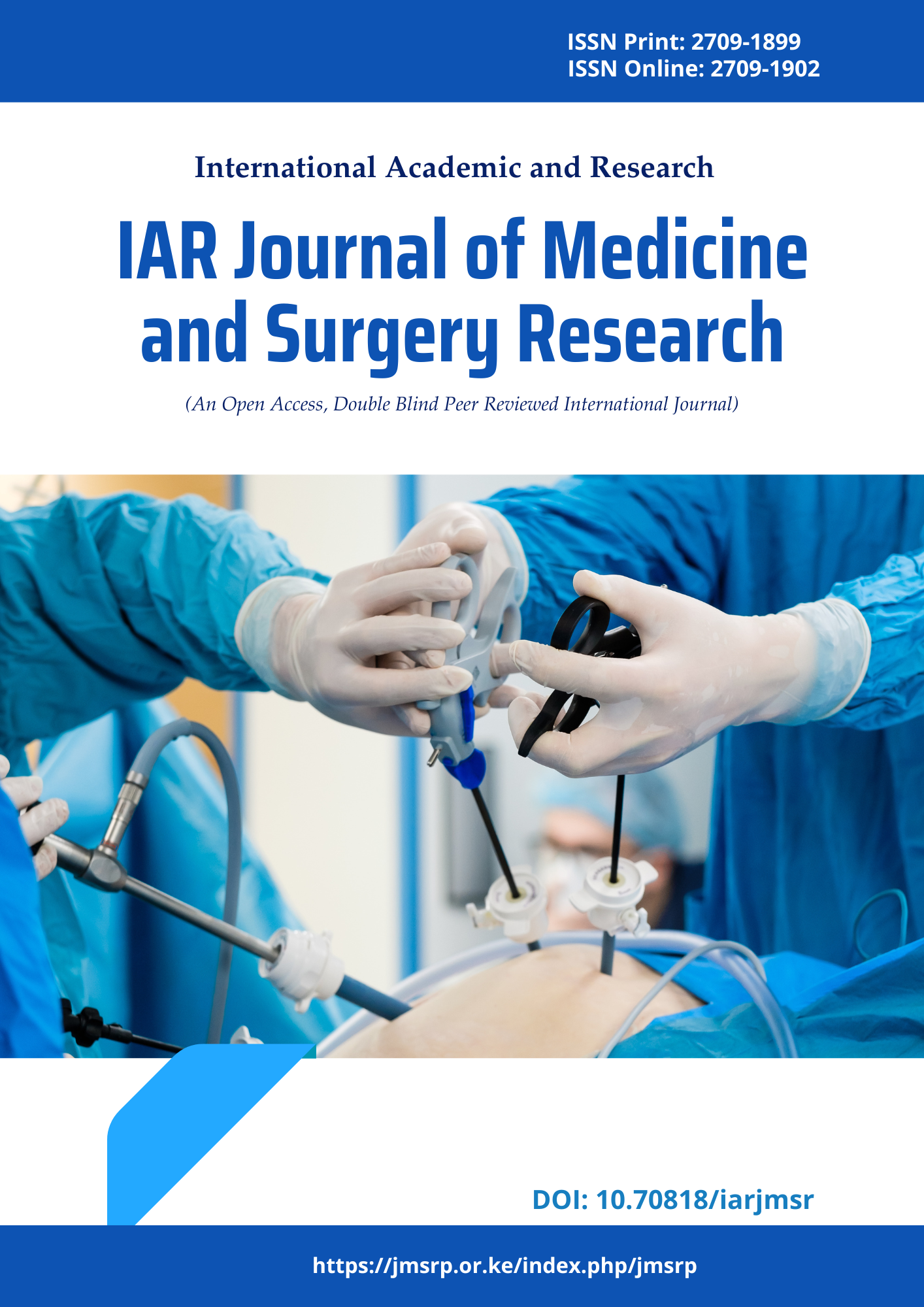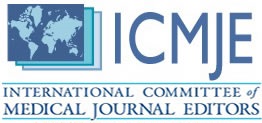Major Risk Factor for Cervical Cancer in Rural Area How to Reduce its incidence Along Mortality Rate
DOI:
https://doi.org/10.70818/iarjmsr.2024.v05i06.0152Keywords:
Cervical Cancer, HPV, Socio-Economic Factors, Public Health InterventionAbstract
Introduction: Cervical cancer is a major public health concern and a leading cause of mortality among women worldwide. Rural populations are disproportionately affected due to socioeconomic barriers and limited access to healthcare services. Background: Cervical cancer is primarily caused by persistent infection with high-risk human papillomavirus (HPV) types. In rural areas, factors such as poor hygiene, early marriage, and inadequate healthcare access contribute to higher incidence and mortality rates. Despite being preventable through screening and vaccination, the disease continues to pose challenges in underserved regions. Methods: This cross-sectional study was conducted in rural Bangladesh, involving 450 participants aged more than 30 years up to 59 years selected via stratified random sampling. Data were collected through structured interviews, clinical assessments, and review of health records to identify sociodemographic, reproductive, and healthcare-related risk factors. Interventions, including HPV vaccination and education campaigns, were implemented, followed by evaluations to assess their effectiveness. Results: The study revealed significant risk factors, including HPV infection (20%), early marriage (44.4%), poor hygiene (55.6%), and limited access to healthcare (66.7%). Targeted interventions led to increased awareness, improved screening participation, and a reduction in HPV prevalence. Conclusion: This study highlights the urgent need for community-based strategies to address cervical cancer disparities in rural populations. Interventions like HPV vaccination, education campaigns, and improved healthcare access have shown substantial potential in reducing cervical cancer incidence and mortality. Prioritizing these efforts is essential for achieving equitable healthcare outcomes for underserved women.
References
Heer, E., Harper, A., Escandor, N., Sung, H., McCormack, V., & Fidler-Benaoudia, M. M. (2020). Global burden and trends in premenopausal and postmenopausal breast cancer: a population-based study. The Lancet Global Health, 8(8), e1027-e1037.
Khazaei, Z., Namayandeh, S. M., Beiranvand, R., Naemi, H., Bechashk, S. M., & Goodarzi, E. (2021). Worldwide incidence and mortality of ovarian cancer and Human Development Index (HDI): GLOBOCAN sources and methods 2018. Journal of preventive medicine and hygiene, 62(1), E174.
Morgan, E., Arnold, M., Gini, A., Lorenzoni, V., Cabasag, C. J., Laversanne, M., ... & Bray, F. (2023). Global burden of colorectal cancer in 2020 and 2040: incidence and mortality estimates from GLOBOCAN. Gut, 72(2), 338-344.
Okunade, K. S. (2020). Human papillomavirus and cervical cancer. Journal of Obstetrics and Gynaecology, 40(5), 602-608.
Huang, J., Deng, Y., Boakye, D., Tin, M. S., Lok, V., Zhang, L., ... & NCD Global Health Research Group. (2022). Global distribution, risk factors, and recent trends for cervical cancer: A worldwide country-level analysis. Gynecologic oncology, 164(1), 85-92.
Osmani, V., Hörner, L., Nkurunziza, T., Rank, S., Tanaka, L. F., & Klug, S. J. (2024). Global prevalence of cervical human papillomavirus in women aged 50 years and older with normal cytology: a systematic review and meta-analysis. The Lancet Microbe.
Jeong, S., & Choi, Y. J. (2024). Association between Socioecological Status, Nutrient Intake, and Cancer Screening Behaviors in Adults Aged 40 and Over: Insights from the Eighth Korea National Health and Nutrition Examination Survey (KNHANES, 2019). Nutrients, 16(7), 1048.
Ammitzbøll, G., Levinsen, A. K. G., Kjær, T. K., Ebbestad, F. E., Horsbøl, T. A., Saltbæk, L., ... & Dalton, S. O. (2022). Socioeconomic inequality in cancer in the Nordic countries. A systematic review. Acta Oncologica, 61(11), 1317-1331.
Machado, M. (2023). Educational inequalities in cervical cancer mortality: a systematic review and meta-analysis.
Petersen, Z., Jaca, A., Ginindza, T. G., Maseko, G., Takatshana, S., Ndlovu, P., ... & Moyo, S. (2022). Barriers to uptake of cervical cancer screening services in low-and-middle-income countries: a systematic review. BMC women's health, 22(1), 486.
Khan, M. J., Kannan, P., Sayma, & Winser, S. J. (2024). Population-based cross-sectional survey of cervical cancer screening prevalence and socio-demographic correlates in Bangladeshi women. Research in Health Services & Regions, 3(1), 17.
Singh, D., Vignat, J., Lorenzoni, V., Eslahi, M., Ginsburg, O., Lauby-Secretan, B., ... & Vaccarella, S. (2023). Global estimates of incidence and mortality of cervical cancer in 2020: a baseline analysis of the WHO Global Cervical Cancer Elimination Initiative. The lancet global health, 11(2), e197-e206.
Trewin-Nybråten, C. B. (2023). Changing socioeconomic patterns of breast cancer incidence, mortality and survival in Norway.
Mahumud, R. A., Keramat, S. A., Ormsby, G. M., Sultana, M., Rawal, L. B., Alam, K., ... & Renzaho, A. M. (2020). Wealth-related inequalities of women’s knowledge of cervical cancer screening and service utilisation in 18 resource-constrained countries: evidence from a pooled decomposition analysis. International journal for equity in health, 19, 1-15.
Rajaguru, V., Kim, T. H., Shin, J., & Lee, S. G. (2022). Income disparities in cancer screening: a cross-sectional study of the Korean National Health and Nutrition Examination Survey, 2013–2019. Frontiers in Public Health, 10, 820643.
Begum, M. M. M., Gupta, R., Sunny, B., & Lutfor, Z. L. (2024). Advancements in Early Detection and Targeted Therapies for Breast Cancer; A Comprehensive Analysis. Asia Pacific Journal of Cancer Research, 1(1), 4-13.
Gupta, R., & Rahman, M. T. (2024). Revolutionizing Cancer Care; Breakthroughs in Therapeutics and Diagnostics for Precision Oncology. Asia Pacific Journal of Cancer Research, 1(1), 1-3.
Khatun, M. M., & Begum, M. M. M. (2024). Enhancing Cervical Cancer Screening VIA vs. Colposcopy; A prospective study. Asia Pacific Journal of Surgical Advances, 1(1), 15-25.
Parvez, M. H., Moula, S. G., Islam, M. M., Badruddoza, A. S. M., & Ali, M. I. (2024). Impact of Surgeon Experience on Outcomes in Prostate Cancer Surgery; A Study of Learning Curves and Best Practices. Asia Pacific Journal of Cancer Research, 1(1), 23-31.
Borna, N. A., Khatun, W., Lina, K. S. N., Parven, R. P., & Haque, A. T. (2024). Assessing the Impact of Laparoscopic Surgery on Metabolic and Reproductive Outcomes in Women with Polycystic Ovary Syndrome. Asia Pacific Journal of Surgical Advances, 1(1), 25-33.
Downloads
Published
Issue
Section
License
Copyright (c) 2024 A A M Abu Taher, Aziz Ahmed, Md Jahangir Alam, Shilpi Rani Roy, Mominul Islam, Md Lutfar Rahman, Maksuda Zahan Akhi, Israt Jahan Jui (Author)

This work is licensed under a Creative Commons Attribution 4.0 International License.















